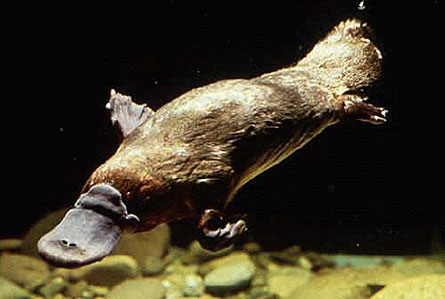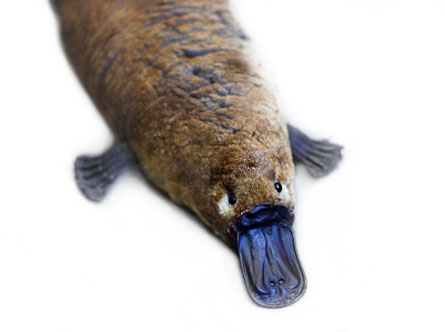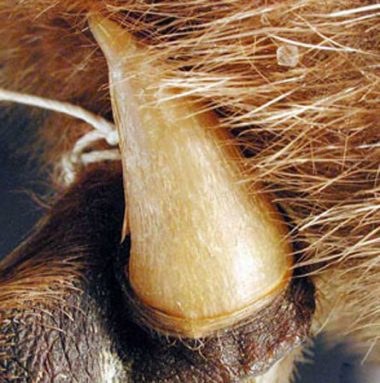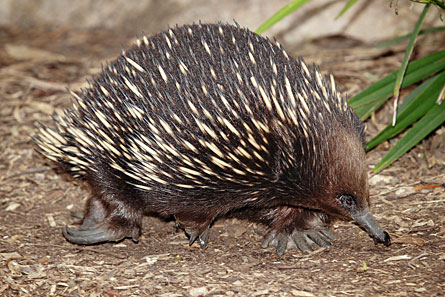Pondering the puzzling platypus
Scientists are studying the mixed-up looking mammal for clues to animal ancestry
 |
|
The platypus is one of two kinds of mammals that lay eggs instead of giving birth to live young. Scientists are studying these creatures to better understand how reptiles gave rise to mammals.
|
| striatic / flickr |
The first European scientist who saw a platypus thought it was a fake.
In the late 18th century, British scientist George Shaw received a package from the governor of Australia. Shaw found strange things when he opened the box. He found a preserved pelt of chocolate brown. The face on the pelt looked like a rodent’s, but with a duckbill. Instead of paws, the creature had ducklike feet. Looking at all this, Shaw thought someone had sewn duck parts onto a beaver as a joke.
Of course, the platypus is real. “They’re cute and funny at the same time,” says genome scientist Wesley Warren about platypuses. He works at Washington University in St. Louis. “That’s why they’re so appealing to so many people.”
With its rich fur and funny bill and feet, the platypus looks cuddly. But don’t be fooled. Male platypuses make poison that, when they feel threatened, can be injected through sharp spurs on the hind feet. If the spurs stab you, you won’t die. You will, however, be in a lot of pain.
Poison and duck feet aren’t the platypus’s only crazy features. Female platypuses lay eggs — only one of two mammals that do so. What if your dog laid eggs? And while platypuses nurse their babies like all other mammals, they don’t do so through nipples. Instead, young platypuses lap milk from grooves in their mother’s belly.
The weirdness doesn’t stop there. Platypuses also have special organs called electroreceptors, which are used to sense a platypus’s surroundings when it swims. Electroreceptors both create electric fields and detect changes in those fields. The organs let platypuses find food in murky water. While very few mammals have these organs, many primitive fish (like sharks and rays) do.
“There’s a very unique biology associated with the platypus,” Warren said, and he might have understated his case.
 |
|
Platypuses have bills and webbed feet like a duck, and also have egg-laying in common with the birds. But fur and young that nurse are mammalian features.
|
| Doctor_bass / iStockphoto |
In the platypus, nature has put familiar characteristics together in an unfamiliar way. Fur and milk are characteristic of mammals, but where are platypuses’ nipples? Some fish have electroreceptors, as do echidnas, the other egg-laying mammal. Birds have beaks, eggs and webbed feet. Reptiles make poison and lay eggs, too.
Because platypuses have reptilian features, they’re the perfect study subjects for scientists who wonder how reptiles gave rise to mammals about 270 million years ago.
Recently, Warren and his colleague Richard Wilson, also at Washington University, put together a team of 102 scientists to study the platypus genome. A genome is an individual blueprint, like a map or a plan, for a creature. An organism’s genome has all its hereditary information. And that information is encoded, like a secret message, in a long molecule called DNA.
Scientists from universities and research institutes all over the world worked on this platypus genome project. Warren and Wilson split the DNA decoding among a number of specialized groups.
 |
|
Like reptiles, platypuses lay eggs and make poison. Spurs on the hind feet of platypuses deliver the toxin when the mammals feel threatened.
|
| stowe boyd / flickr |
One group studied fragments of DNA that move around within the genome of a single cell. Another group examined very short fragments of DNA that repeat themselves. Another studied active portions of the genome, those parts that code for a message, while yet another group studied the inactive portions of the genome. All of these groups have multiple scientists, so the project is made up of a lot of scientists.
With so many scientists cooperating, you might think they’d produce an encyclopedia of knowledge. But examining the genome of one animal, even one as odd as the platypus, doesn’t tell you very much. Eric Lander at the Broad Institute in Cambridge, Mass., explained it this way: “If you really want to understand a genome, you have to compare it to other genomes.”
After they decoded the platypus DNA, Warren and his colleagues compared the genome to other creatures. But which other creatures?
Choices are limited. Scientists have decoded the DNA of roughly 1,000 creatures, but many of those are bacteria and viruses. Approximately 40 mammals have had their genome mapped. Of the birds, only the chicken has had its genome decoded.
“And for reptiles,” says Warren, “there’s the turtle genome we’re sequencing now, and the green anole lizard was recently sequenced. That’s it.”
Why have scientists mapped so few complex organisms? The answer is time and money. The first complex organism to have its DNA decoded was a roundworm called C. elegans. It took eight years to complete that decoding. The platypus genome project was completed in only four months, but it had the benefit of information from previous genome decodings and cost nine million dollars. That’s a lot of money.
Both the time and money needed to complete genome projects are decreasing as technology improves.
“In the future, you’ll be able to sequence a genome of platypus size for maybe a million dollars in two months,” says Warren.
 |
|
Echidnas are egg-laying mammals, like platypuses. Platypuses live in freshwater in Australia; echidnas are terrestrial and live in Australia and the large island of New Guinea.
|
For now, scientists who want to understand platypus evolution (or how, over millions of years, the creature came to be the strange mammal that it is) have only a few species available for comparison. Still, scientists were able to learn a lot with what they had. They compared the platypus genome to that of humans, the anole lizard and the chicken. This allowed them to examine the platypus’ mammalian features (lactation, or milk production), its reptilian features (electroreceptors, poison and some aspects of egg laying) and its avian features (the duckbill and feet, and some features of egg laying).
The first mammals gave rise to two groups of mammals 166 million years ago. One group includes platypuses and echidnas, which look like a pincushion. The other group includes humans. By comparing the genomes of humans and platypuses, scientists found that both species have genes to make the same kind of milk, even though platypuses don’t have nipples. Because both species make milk using the same gene, scientists know that mammals have been making milk for more than 166 million years, which is when humans and platypuses last had an ancestor in common. So, this common ancestor also made milk.
The scientists also looked at genes that make platypus electroreceptors. These genes aren’t found in mammals or lizards. This means that platypuses didn’t inherit electroreceptors from some distant relative. And the scientists also found that although many reptiles make poisons, they don’t use the same genes as platypuses do to make their poisons. This means the platypus evolved unique genes for making both electroreceptors and poison.
Scientists also compared genes from the platypus to those of chickens and humans to understand the evolution of egg formation. Scientists found genetic material in common with platypuses and humans, but not with chickens. This explains some similarities between human eggs and platypus eggs. For example, both species have a membrane surrounding the egg.
The platypus genome project also found that platypuses, chickens and lizards share genes that humans lack. For example, lizards and chickens have three genes that help them make egg yolks, platypuses have one of these genes and humans have none of these genes. This number of egg-yolk genes tells us about how animals evolved ways to get nutrients to their young. With three genes to produce egg yolk and no genes to produce milk, chickens and lizards (both of which split from mammal-like reptiles about 315 million years ago) deliver nutrition to their young wholly from egg yolk. With milk-producing genes and one egg-yolk gene, platypuses rely more on milk than yolk — but they still use yolk. Humans, who have milk genes but no genes for yolk, deliver their nutrition to their young with milk.
Scientists have discovered that in the case of the platypus, looks aren’t deceiving. Platypuses really are a mixture of lizard, bird and mammal — with a dash of something uniquely platypus tossed in.
“It makes you scratch your head and wonder how nature could let this happen,” Warren said. And, “how all these ancient reptilian structures could survive.”
Scientists still don’t know what all platypus genes do. When they figure out more about the mystery genes, scientists will understand the way mammals evolved even better than researchers do today. Did the very first platypuses have electroreceptors like sharks do, or did platypuses evolve these organs later? Someday, scientists like the ones studying the platypus genome might be able to tell us the answer.
And what’s Wesley Warren going to do now that he’s finished this huge platypus project? He’s helping figure out the genomes of other animals — the zebra finch, a common striped bird with a bright red beak, and the western painted turtle.







